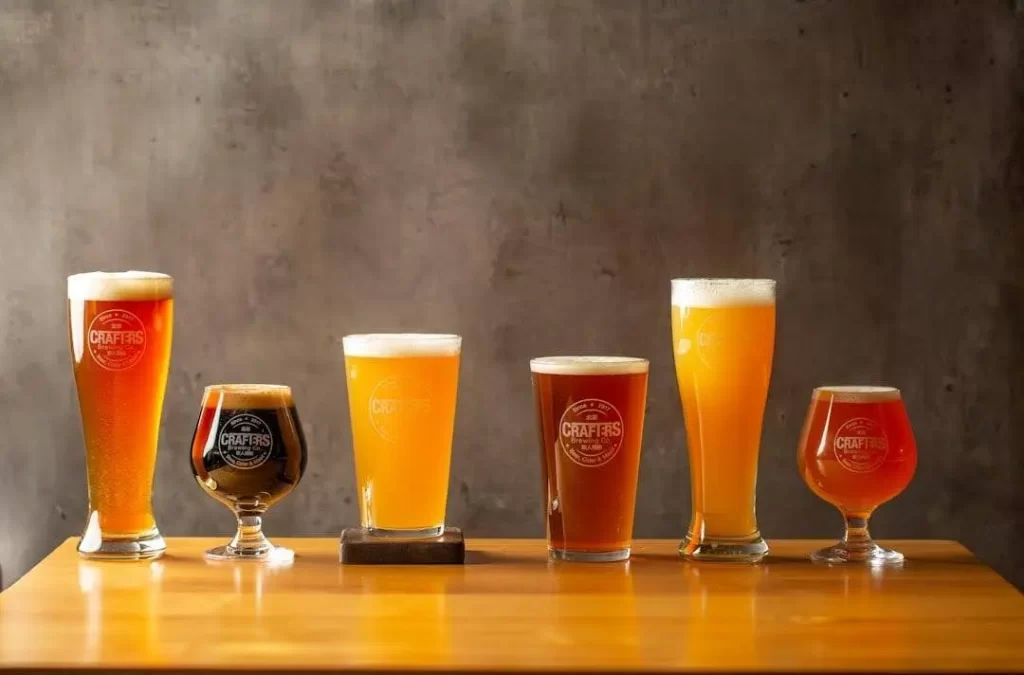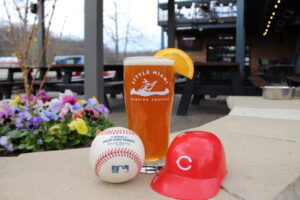CONTACT INFO
208 Mill Street, Milford, Ohio 45150
reserve@littlemiamibrewing.com
OPERATING HOURS
- Sunday: 11:00 am - 9:00 pm
- Monday: 11:00 am - 9:30 pm
- Tuesday: 11:00 am - 9:30 pm
- Wednesday: 11:00 am - 9:30 pm
- Thursday: 11:00 am - 10:00 pm
- Friday: 11:00 am - 11:30 pm
(Kitchen closes at 10:00 pm) - Saturday: 11:00 am - 11:30 pm
(Kitchen closes at 10:00 pm)
Craft beers are one of the most popular beer types by consumption, with almost 11% of the market share in the U.S. Craft beer is often made in small batches by independent breweries that value quality and creativity over mass-market profits. As a result, they create innovative beers that captivate the hearts of many beer drinkers. Our brewery in Cincinnati thrives because of the variety of craft beers available for our patrons.
Whether you’re a passionate beer drinker, considering delving into the world of home brewing, or just want to learn more about the beer you drink, this article will help you get a beginner’s understanding of the four types of craft beer: ales, lagers, stouts, and porters. We’ll lay out all the characteristics, beer flavor types, and brewing methods of each type and explore the basics of beer brewing. First, let’s go through styles of beer.
How Many Craft Beer Styles Are There?
Considering all major beer categories and their sub-styles, there are well over 100 beer styles worldwide.
Top 4 Craft Beer Types and Styles You Should Know
First, every beer is either an ale or a lager. Ales are generally made at higher temperatures, while lagers ferment at cold temperatures, a storage process called “lagering.”
The two other main types of craft beers are hybrids (a beer with elements of both lagers and ales) and wild or sour craft beers, which include several types of beer characterized by their tart, acidic flavor profile. Let’s learn more about each of them.
1. Lager Beers
Lager beer is the most popular type of craft beer in most countries for its carbonation and subtle hops, making it an easy-to-drink, refreshing beer. They rank low on the bitter scale, usually within 4 to 45 International Bitterness Units. Lager yeast settles to the bottom during fermentation and is conditioned at low temperatures, so it takes longer to ferment. Then it goes through a maturation stage, during which it’s stored or “lagered.” You can find many types of lagers like:
- Bocks: Of the lagers, bocks are probably the most rich and malty. They have higher alcohol content and are often dark in color. Flavor notes include toasted bread, dark fruit, and caramel.
- Pilsners: Iconic and popular, pilsners are fan favorites for refreshing, easy-to-drink golden brews. Pilsners are balanced creations originating in Prague and replicated in countless countries. In fact, some of the most popular commercially made American lagers are pilsners.
- Dunkels: Dark beers with a smooth and roasted malt profile, nutty flavors, and a clean finish, dunkels are great Oktoberfest beers that pair well with German dishes like sausages and roasts.
2. Ale-Style Beers
Ales are the beers of our ancestors. Hops weren’t introduced into beer-making until around the 8th century. Ales are defined by the style of yeast they use in fermentation. They’re generally more hoppy and flavorful, often even fruity. Ale-style beers frequently use top-fermenting yeast that gathers at the top of the tank during the brewing process and requires warmer temperatures to ferment. This beer needs no storage since it’s better with no or little aging.
Categories of popular ales you may have tried include:
- Pale ales: This style is a balanced beer with both hoppy bitterness and malty sweet flavors. Because of the pale malt used, it exhibits colors from golden to amber and highlights its hoppy aromas. The pale ale isn’t alone in its category. There are also types of IPAs (India pale ales) with many hoppy flavors drinkers enjoy.
- Porters: Porters are dark, flavorful ales with rich maltiness and hints of chocolate, coffee, and caramel, providing a creamy mouthfeel that comes from its malted barley.
- Stouts: Like porters, stouts are beers with malt flavors and notes of coffee, chocolate, and dark fruit. However, they’re often richer, darker, and more robust.
- Wheat beers: Also known in German as witbiers or hefeweizens, these are refreshing brews with a significant helping of wheat malt. They’re cloudy and creamy and often highlight flavors like banana, clove, and citrus.
3. Hybrid Beers
As mentioned, hybrid beers take brewing practices from ales and lagers and use them to create new flavors and aromas. An example of this could be a beer that uses ale yeast and a lagering method. Some of these beers include:
- Kölsch: A kölsch is a Cologne-born beer made with ale yeast and cold conditioning, well-known for being easy to drink and refreshing. It’s characterized by its pale golden color, delicate maltiness, and subtle fruity notes.
- Altbier: This dark-colored German beer uses ale yeast with cold fermentation (a lager brewing method). Its name translates to “old beer” and refers to its traditional method. They’re rich brews with a subtle hop bitterness and a great blend of cozy flavors like caramel and nuts.
- California common: Also known as steam beer, this American hybrid-style beer uses lager yeast with a warm-temperature fermentation. It’s a crisp, lager-style beer with fruity notes.
4. Wild or Sour Craft Beers
If you’ve been dabbling in craft beers, you’ve probably had a sour beer before. Sours are known for their bright, tart flavor, which results from a controlled process. Some differentiating elements needed to make wild or sour beer include wild yeast and oak barrels. With these elements, brewers can use spontaneous fermentations, mixed-culture fermentations, or kettle souring.
Sour beer fermentation is spontaneous, which means a brewer exposes the brew to wild bacteria, yeast, and microflora in the air, resulting in more complex flavors. Mixed culture, or the “traditional method,” is common and known for producing high-quality sour beers. It includes introducing live bacteria and souring microorganisms into the fermentation cycle early, which increases tartness over time. Finally, kettle souring is the same as mixed culture, but the bacteria are added to the wort or the substance that eventually becomes the beer.
Sour beer types:
- Berliner Weisse: This classic German sour beer is known for its refreshing taste. Usually pale in color, it’s an unfiltered wheat beer with a fruity flavor.
- Gose: Another German sour wheat beer, goses are tart and lemony with notes of cilantro and salt.
- Lambic-style: This Belgian beer uses spontaneous fermentation to produce a surprisingly wide range of flavors. It’s versatile enough to pair with many foods, including shellfish, chocolate cake, and more.
- Flemish brown: This is one of the Belgian beers from Flanders that brewers store for two years in oak barrels. This process allows the brown ale to develop more complex, rich flavors with malty highlights and tartness.
Kettle-soured: These beers are great for cutting production time, so you’ll find many commercial brands using this method. It’s a modern, no-fuss approach to sour beer and is often bright in flavor and low in alcohol by volume.
Enjoy a Wide Variety of Craft Beers at Little Miami Brewing
The possibilities of craft beer are why hobbyists never get bored, and you’re now well on your way to becoming an expert in the craft beer scene.
Explore the expansive and varied realm of craft beers at Little Miami Brewing, where you’ll uncover the best of Cincinnati’s craft beer — an extensive selection of flavors, styles, and brews that will excite your palate and quench your thirst for adventure. From refreshing lagers to bold ales, inventive hybrids, and enticing sour beers, there’s a brew to please every beer enthusiast. Join us at Little Miami Brewing and embark on a delightful journey of exploration with every sip.




